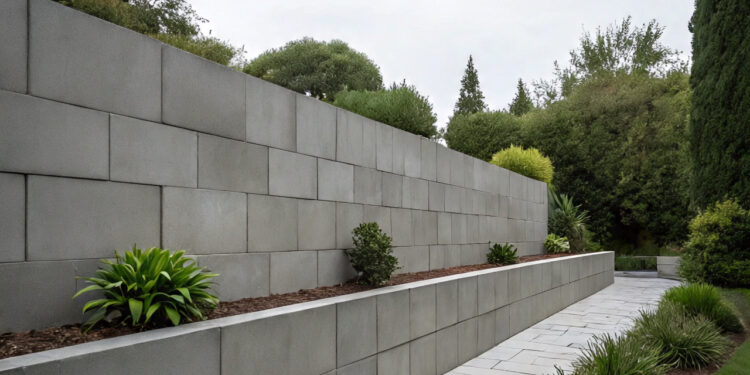In modern landscape design, functionality and beauty often go hand in hand. Every element—whether a pathway, garden, or structure—serves a purpose while contributing to the overall aesthetic. Among these, retaining walls stand out as both practical and visually striking features. Once purely structural, they have evolved into central design statements that define space, texture, and identity within an outdoor environment.
For professionals like K-Ler Landworks, retaining walls are more than support systems; they are opportunities to express creativity while ensuring stability. When designed with care and precision, these walls bring structure and artistry together, enhancing the landscape’s appeal while addressing essential needs such as soil control and space creation.
The Evolution of Retaining Walls
Historically, retaining walls were used to prevent erosion and support slopes. Built from stone or timber, they were functional but often overlooked in design discussions. Over time, however, the role of these structures expanded beyond stability. They became integral to the visual composition of outdoor spaces, adding depth, form, and balance.
Today, homeowners and designers see retaining walls as architectural features that frame gardens, create levels, and complement the home’s design style. By merging engineering precision with artistic intent, retaining walls have become defining elements of contemporary landscaping.
Function Meets Form
While their core purpose remains structural, retaining walls now perform a dual role. They provide necessary support while acting as focal points that anchor a landscape’s design.
Functionally, these walls hold back soil, prevent erosion, and make sloped areas usable. But aesthetically, they introduce dimension and texture, breaking up flat terrain and adding contrast to green spaces. A well-placed wall can guide movement, draw attention to a focal area, or create symmetry in an otherwise uneven landscape.
K-Ler Landworks designs retaining walls that bring balance to both structure and style—ensuring that beauty never compromises stability.
The Art of Material Selection
The choice of materials is where retaining walls truly take on personality. Each option conveys a different aesthetic and complements specific landscape styles.
- Natural Stone: Offers timeless elegance and organic texture, blending seamlessly with surrounding greenery.
- Concrete Blocks: Provide durability and modern appeal, ideal for structured, contemporary spaces.
- Boulders or Fieldstone: Create a rugged, natural appearance perfect for rustic or nature-inspired designs.
- Timber: Adds warmth and character but requires maintenance for long-term preservation.
The right material not only affects the wall’s strength but also determines its tone and visual impact. Mixing materials—such as stone and metal accents—can elevate the design, turning an ordinary wall into an artistic feature.
Creating Depth Through Layers and Lines
In landscape design, retaining walls are often used to manipulate depth and perspective. Multiple walls placed at varying heights can create terraced gardens, adding a layered look that enhances visual interest.
These terraces can be used for planting flowers, shrubs, or even small trees, transforming what might otherwise be wasted slope into a dynamic, usable area. The interplay of light and shadow across the surfaces adds texture and movement to the design.
Curved walls, in particular, create softness and flow, while straight lines convey order and modernity. By combining these forms, designers can craft outdoor spaces that feel both structured and organic.
Integrating Greenery and Texture
One of the most compelling trends in modern wall design is the integration of plant life directly into the structure. Creeping vines, ornamental grasses, or cascading flowers soften the appearance of stone or concrete, blending natural and built elements.
This approach enhances biodiversity while adding color and movement throughout the year. Vertical gardens, for example, use retaining walls as living canvases, supporting plant growth in limited spaces.
K-Ler Landworks often incorporates native plant species into wall designs, ensuring easy maintenance and year-round vitality. This fusion of hardscape and greenery transforms retaining walls into living, breathing components of the landscape.
Lighting for Ambiance and Safety
The addition of lighting can completely transform the character of retaining walls after sunset. Subtle illumination highlights textures, outlines steps or paths, and creates a sense of depth.
Recessed or under-cap lighting casts gentle glows that emphasize contours, while spotlights draw attention to specific design features. Beyond aesthetics, lighting also enhances safety by illuminating edges, stairs, and walkways.
Strategic placement allows the wall to serve as both a structural and atmospheric feature—guiding movement while setting the mood for evening relaxation or entertainment.
Beyond Boundaries: Functional Creativity
Retaining walls are versatile by nature. Beyond their primary purpose, they can serve as seating, planters, or even art installations.
Low walls can double as benches around fire pits or patios, while taller walls can include built-in planters or shelving for decorative objects. With creative design, these structures become interactive parts of the landscape rather than mere dividers.
Their adaptability allows homeowners to get more use from every square foot of outdoor space while maintaining a cohesive, stylish appearance.
Sustainability and Longevity
The best retaining walls are built to last—and to coexist harmoniously with the environment. Using locally sourced materials reduces environmental impact, while proper drainage systems prevent soil erosion and water damage.
Sustainable practices also include using permeable materials that allow rainwater to pass through, minimizing runoff and promoting groundwater recharge.
K-Ler Landworks emphasizes environmentally conscious design, ensuring every wall contributes positively to both the landscape and its long-term health. Strength, efficiency, and sustainability are built into every project.
Adding Character to Outdoor Architecture
When thoughtfully designed, retaining walls do more than support—they express identity. Their materials, lines, and textures mirror architectural elements of the home, creating unity between indoor and outdoor spaces.
Walls can frame entryways, define garden edges, or serve as backdrops for sculptures and water features. Each design choice adds personality and storytelling to the property.
What was once a purely functional structure becomes a signature feature—a reflection of the homeowner’s style and the designer’s vision.
Final Thoughts
Retaining walls are where utility meets artistry. They shape the land, define boundaries, and transform ordinary yards into extraordinary landscapes. When designed with care, they become statements of craftsmanship and character.
With the expertise of K-Ler Landworks, homeowners can enjoy retaining walls that balance beauty, stability, and sustainability. These structures don’t just support the earth—they elevate the entire outdoor experience, merging creativity and function in lasting harmony.
A retaining wall isn’t just a necessity—it’s an opportunity to make the landscape unforgettable.







